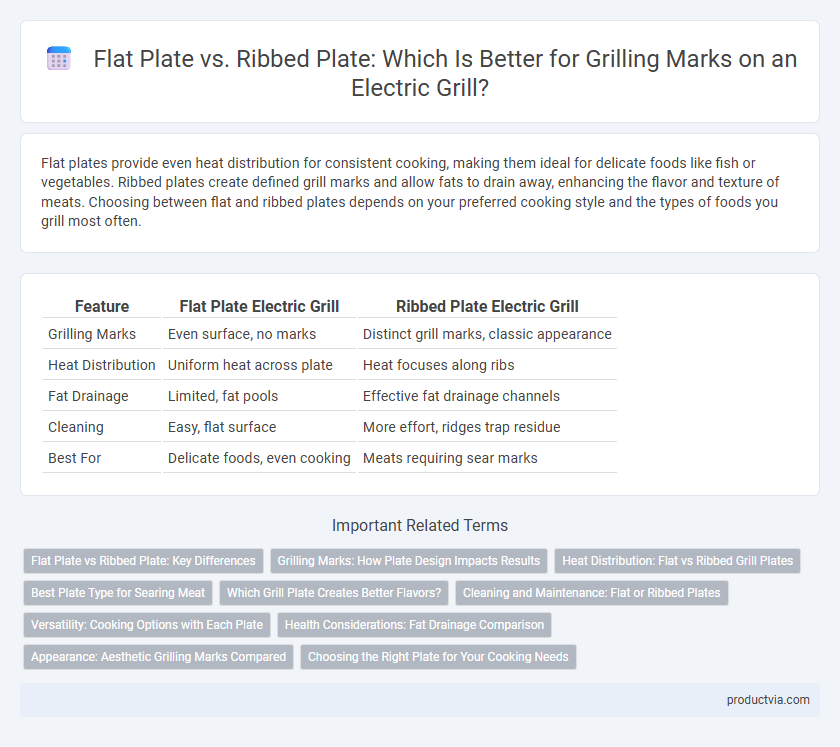Flat plates provide even heat distribution for consistent cooking, making them ideal for delicate foods like fish or vegetables. Ribbed plates create defined grill marks and allow fats to drain away, enhancing the flavor and texture of meats. Choosing between flat and ribbed plates depends on your preferred cooking style and the types of foods you grill most often.
Table of Comparison
| Feature | Flat Plate Electric Grill | Ribbed Plate Electric Grill |
|---|---|---|
| Grilling Marks | Even surface, no marks | Distinct grill marks, classic appearance |
| Heat Distribution | Uniform heat across plate | Heat focuses along ribs |
| Fat Drainage | Limited, fat pools | Effective fat drainage channels |
| Cleaning | Easy, flat surface | More effort, ridges trap residue |
| Best For | Delicate foods, even cooking | Meats requiring sear marks |
Flat Plate vs Ribbed Plate: Key Differences
Flat plates provide even heat distribution and a smooth surface ideal for cooking delicate items without sticking, while ribbed plates create pronounced grill marks and allow fat to drain away from food, enhancing flavor and reducing grease. Ribbed plates elevate food slightly above the surface, promoting searing and smokiness, whereas flat plates offer consistent contact for uniform cooking and easier cleaning. Choosing between them depends on whether aesthetic grill marks and fat drainage or precise heat control and versatility are prioritized.
Grilling Marks: How Plate Design Impacts Results
Flat plates produce even heat distribution, ensuring consistent cooking without distinct grilling marks, ideal for delicate foods and sandwiches. Ribbed plates create raised sear lines by elevating food from the plate surface, producing characteristic grill marks that enhance flavor through Maillard reaction hotspots. The choice between flat and ribbed plates significantly affects the visual appeal and texture of grilled foods, influencing both presentation and taste.
Heat Distribution: Flat vs Ribbed Grill Plates
Flat grill plates provide even heat distribution across the entire cooking surface, ensuring uniform cooking and consistent browning on various foods. Ribbed grill plates create distinct grill marks by concentrating heat along the raised ridges, but may lead to uneven cooking in the valleys between ribs. Choosing between flat and ribbed plates depends on priority: flat plates for consistent heat and versatility, ribbed plates for classic grill marks and fat drainage.
Best Plate Type for Searing Meat
Flat plates provide consistent, even heat distribution, ideal for evenly searing meat and locking in juices. Ribbed plates create distinct grill marks that enhance the visual appeal and allow fats to drain away, preventing flare-ups while adding a smoky flavor. The best plate type depends on whether you prioritize uniform cooking or authentic grill aesthetics and texture.
Which Grill Plate Creates Better Flavors?
Flat plates provide even heat distribution for consistent cooking and are ideal for delicate items, while ribbed plates create distinct grill marks that enhance flavor through caramelization and fat rendering. Ribbed plates excel at producing the classic smoky taste associated with outdoor grilling by allowing juices to drip away, reducing steaming and promoting searing. For richer, charred flavors and visually appealing marks, ribbed grill plates outperform flat plates in flavor development.
Cleaning and Maintenance: Flat or Ribbed Plates
Flat plates offer easier cleaning and maintenance due to their smooth surface, allowing grease and food residue to be wiped away quickly without getting trapped. Ribbed plates, while ideal for creating grill marks, tend to accumulate grease and food particles in the grooves, requiring more detailed scrubbing and higher maintenance. Choosing between flat or ribbed plates depends on whether ease of cleaning or the aesthetic of grill marks is a higher priority.
Versatility: Cooking Options with Each Plate
Flat plates provide even heat distribution ideal for cooking delicate foods like pancakes and vegetables, offering versatility beyond typical grilling. Ribbed plates create distinctive grill marks and allow fat to drain, enhancing flavor and texture for meats such as steaks and chicken. Choosing between flat and ribbed plates depends on the variety of dishes you plan to prepare and whether you prioritize searing marks or multi-purpose cooking.
Health Considerations: Fat Drainage Comparison
Flat plates provide a consistent surface that retains juices and fats, potentially increasing calorie intake and promoting smoke formation during grilling. Ribbed plates create raised ridges that allow excess fat to drain away from the food, reducing fat consumption and contributing to healthier cooking. Choosing ribbed plates supports lower fat retention and minimizes exposure to harmful compounds produced by fat dripping on heat sources.
Appearance: Aesthetic Grilling Marks Compared
Flat plates provide a uniform grilling surface that cooks food evenly but lack the distinctive charred lines essential for aesthetic appeal. Ribbed plates create pronounced grilling marks that enhance the visual presentation of meats and vegetables, making dishes more attractive and appetizing. These raised ridges also allow fats to drain away, contributing to cleaner grill marks and a professional look that flat plates cannot achieve.
Choosing the Right Plate for Your Cooking Needs
Flat plates provide even heat distribution ideal for cooking delicate foods like vegetables and pancakes, while ribbed plates create distinct grill marks and allow fat to drain away, enhancing flavor for meats. Choosing between flat and ribbed plates depends on your preferred cooking style and desired presentation; flat plates offer versatility, whereas ribbed plates emphasize classic grilled textures. Consider your typical recipes and maintenance preferences to select the plate that best suits your grilling needs.
Flat plate vs ribbed plate for grilling marks Infographic

 productvia.com
productvia.com